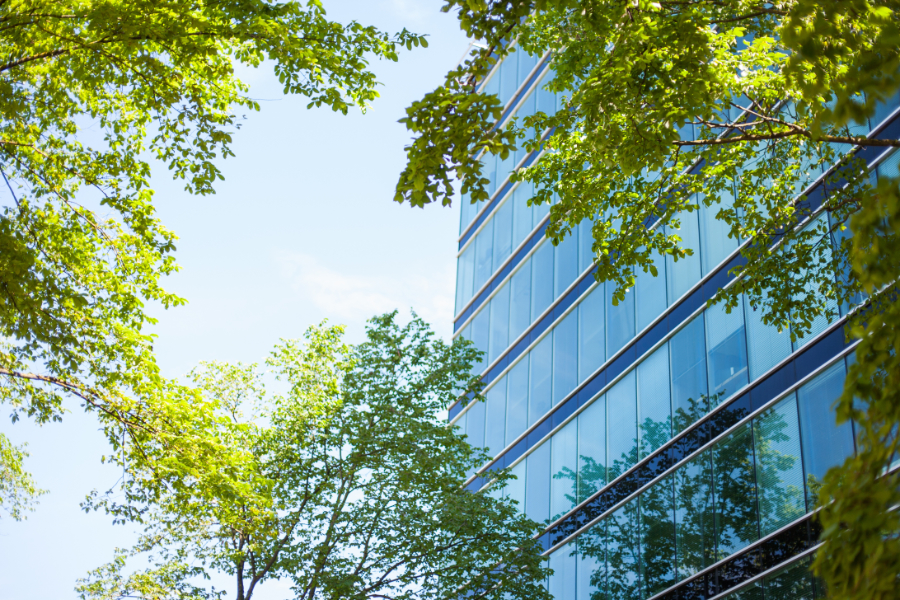It did not take long for the COVID-19 pandemic to begin reshaping the way we live and work. Although the crisis is by no means over, as the world looks forward to the eventual recovery, industry leaders, including those in commercial real estate, are recognizing that now is an opportune time to put a focus on rebuilding sustainably. While the COVID-19 crisis is new (and will one day be just a memory), the climate crisis has been around for decades and will continue to be a threat unless action is taken.
How COVID-19 Impacted the Environment
When the world went on lockdown during the peak of the coronavirus crisis in April 2020, studies show that carbon emissions, air pollution, congestion, and related transport emissions dropped by 17% as offices shuttered, plants closed down, and commuting was put on pause. If there was any silver lining to the pandemic, this was certainly it. Of course, having millions out of work is not an ideal way to achieve a greener Earth, and as places begin to reopen, emission levels will bounce back—unless new policies can be put into place that protect the planet after the pandemic passes.
Of course, it’s not just the United States looking to recover and grow sustainably. Today, more than 200 top UK firms and investors are calling on the government to deliver a COVID-19 recovery plan that prioritizes the environment, and wealthy investors in Asia are also showing more interest in sustainable investment as the pandemic focuses attention on health and the environment.
How Green Initiatives May Impact Commercial Real Estate
Buildings account for around 75% of global greenhouse gas emissions and consume 40% of the world's energy. The commercial real estate (CRE) sector is underperforming compared to other industries in changing its CO2 emissions, which puts some of the blame for the climate change crisis squarely on its shoulders.
In the wake of the pandemic, many CRE industry experts expect that demand will shift more toward efficient properties. Efficient properties were already growing in popularity pre-pandemic, but the coronavirus lockdown may put them into overdrive, as the experience quickly revealed the downsides of energy-intensive buildings. During the lockdown, despite an overall decrease in energy consumption across the board, many empty and semi-empty offices, hotels, and shops continued to waste huge amounts of energy at a significant environmental and financial cost.
Reports show that some were using about 84% of their typical energy demand (with the worst using about 97%), often due to ventilation and heating systems which continued to operate central plant equipment without adjusted standard time schedules. With smart building technologies, energy wastage can be curbed because building performance can be managed and monitored remotely. "In the longer term, this control will also help businesses meet their carbon reduction goals and improve indoor air quality for building occupants," says Carbon Intelligence founder and chief innovation officer Cian Duggan.
That’s not all; the pandemic also showed how pandemics and climate change both can affect the CRE market rather uniquely by causing physical shocks. Because CRE deals in real assets, it has physical fragilities which COVID-19 quickly revealed. For example, many hospitals were shown to be vulnerable in their capacity and flexibility; malls, whose business model is based on the aggregation and proximity of different services, were not prepared for social distancing measures; and office towers relying on elevators were not prepared with an alternative way to transport employees safely. Experts say these shocks will have a big effect on consumer demand and the entire sector in general.
Reinventing Commercial Real Estate Post-COVID
Some real estate investors are already looking to achieve long-term resiliency and mitigating any future physical or market shocks, while also reducing their carbon-footprint, by decarbonizing their CRE portfolio and making their operations sustainable, for example, digitizing their assets and services for tenants and building users. In doing so, they can perform energy health checks on spaces or monitor consumption, reducing CO2 emission levels.
CRE investors are also likely to use some of their resources to build renewable-energy infrastructure and retrofitted buildings. While sustainable projects are slightly more expensive in the short-term, the payback comes fast. According to a report by Dodge Data and Analytics, new and retrofitted green buildings can see up to a 9% decrease in operating costs over 12 months and a 13% to 14% decrease over five years.
There are still other, smaller ways that CRE may go green that can still make a big impact, and it’s not just doing “environmentally friendly” things like recycling and using energy-efficient light bulbs. It’s everything from the construction materials (using domestic products to cut down on energy-wasting travel or processing), employing green building designs that feature stairways more prominently to encourage their use (and employee health), using natural lighting when possible, and creating outdoor workspaces.
The Future is Looking Green: CRE Sustainability
The respondents in that same Dodge Data survey said they expect more than 60% of new projects to be sustainable buildings by 2021, so clearly the future is looking green. Of course, not all of this is simply due to pure environmentalism. Changing regulations have also prompted many companies to go green, and 25% of the respondents did note that this would be a “top trigger driving future green building activity.” But regulatory pressure alone won’t drive sustainability. Consumer demand for safer, healthier, and more sustainable buildings will lead the market into our post-COVID era.








